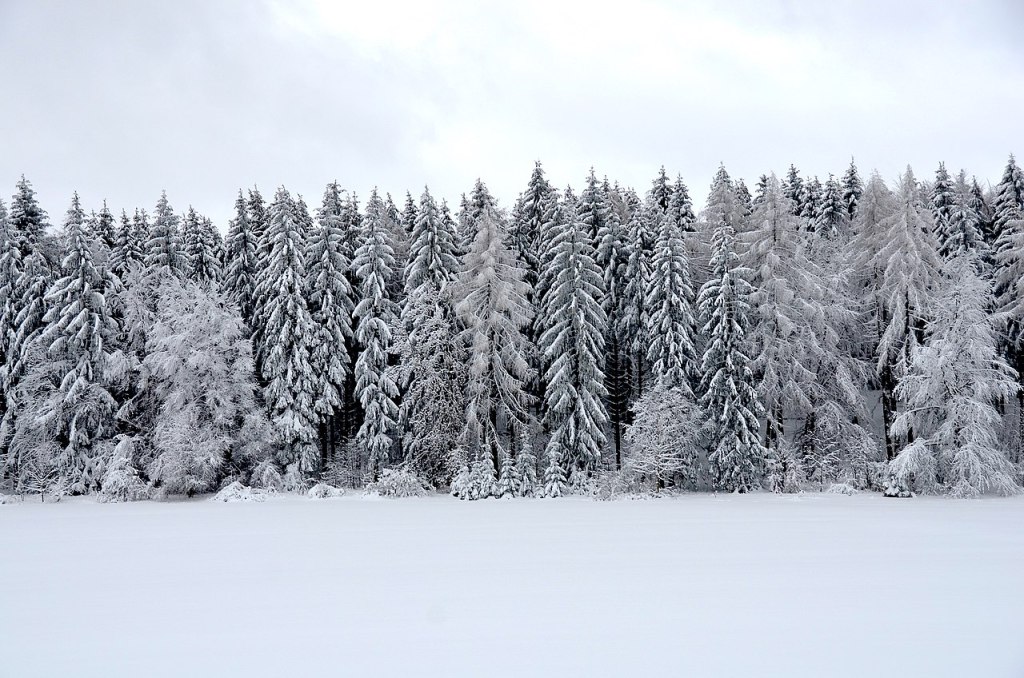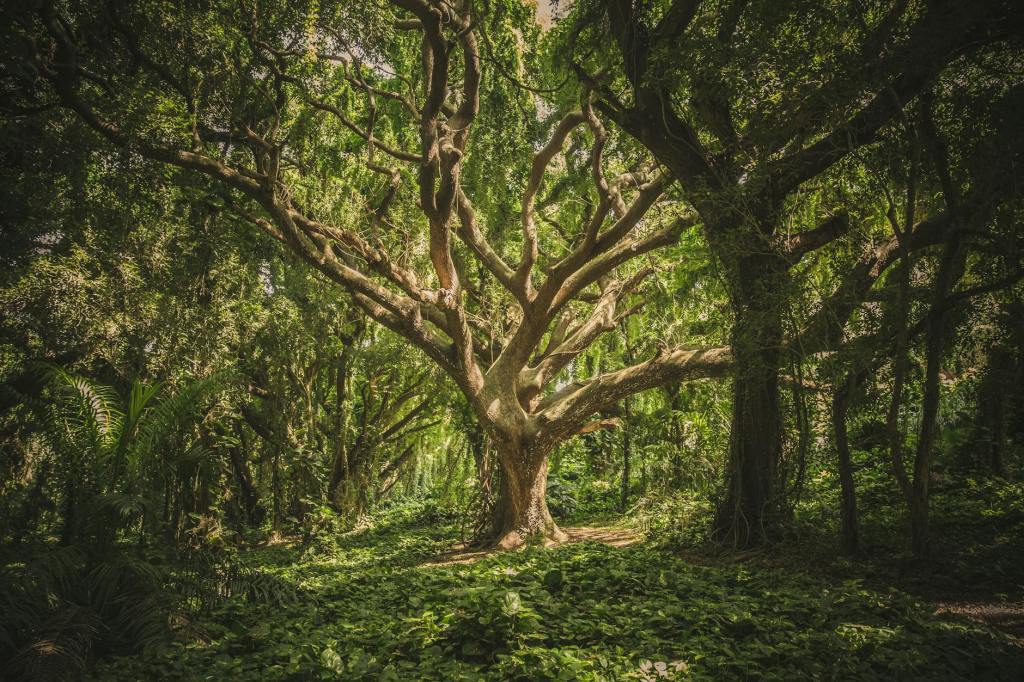
This image, entitled Neuschnee auf der Schwäbischen Alb (2019), by Olga Ernst is used under the Creative Commons Attribution-Share Alike 4.0 International license.
When they are huge, they are awesome. So much so that individual trees and forests (Eleanor Clark) have been likened to Nature’s equivalent of cathedrals (Saumya), human-constructed places of worship*.
When not [well, at the same time as actually…] lifting the soul, improving one’s mental well-being (Simone Kühn et al., Sci Rep 7: 11920, 2017; https://doi.org/10.1038/s41598-017-12046-7) and overall healthfulness [for more on this, see links to shinrin-yoku and forest-bathing here, here, Qing Li (Environ Health Prev Med. 15(1): 9-17, 2010; doi: 10.1007/s12199-008-0068-3), Margaret Hansen et al. (Int. J. Environ. Res. Public Health 14(8): 851, 2017; https://doi.org/10.3390/ijerph14080851), and Fiona Clarke et al. (Sustainability 13(12): 6761, 2021; https://doi.org/10.3390/su13126761)], and delivering intangible benefits to humanity, trees provide many more-tangible resources that are exploited by humans. Resources such as: “food, sugars, starches, spices and condiments, beverages, medicines, essential oils, fatty oils and vegetable fats, waxes, soap substitutes, vegetable ivory, fuel, fiber, pulp and paper, tannins, dyes, rubber, gums, resins and cork” (MK Seth, Bot. Rev 69: 321–376, 2003; https://doi.org/10.1663/0006-8101(2004)069%5B0321:TATEI%5D2.0.CO;2).
That usefulness of trees to humankind has – sadly, but predictably – resulted in their unsustainable over-exploitation in nature (Kathleen Hermans-Neumann et al., Environ. Res. Lett. 11: 125010, 2016; doi: 10.1088/1748-9326/11/12/125010), most dramatically by cutting them down (Hans Nicholas Jong) (“approximately 41 million trees are cut down every day” (Lynn Scarlett)). Furthermore, failure to appreciate how finite and fragile that forest resource is has frequently resulted in loss of their habitat as humans have extended and expanded acreage for agriculture by converting forests to pasture or arable fields (Ellen Heimpel). These practices represent a clear and present danger to trees, to the extent that approx. 30% (Malin Rivers et al., Plants People Planet 5: 466-482, 2023; https://doi.org/10.1002/ppp3.10314) of the planet’s 58,497 tree species that are known to science are considered threatened with extinction. And their loss would mean a reduction in Earth’s biodiversity (Damian Carrington, to the detriment of all species that call this planet home (John Rafferty; Dilys Roe, The Lancet Planetary Health 3(7): e287-e289, July 2019; https://doi.org/10.1016/S2542-5196(19)30113-5).
Furthermore, loss of trees impacts directly upon the indirect benefits to the environment – and hence people more generally – that they and forests provide by way of ecosystem or ecological services (Reagan Pearce, Robert Johnston). For examples of the ecosystem services provided by trees, see here, here, Sophie Badoche, and here.
One of the most globally-beneficial ways in which trees benefit all life on earth is their potential to mitigate the global warming (Sarah Fecht) (and hence climate change) that results from build-up of CO2 in the atmosphere. The way they achieve this is relatively straightforward, it’s down to their physiology. Like other plants, trees undertake photosynthesis. In very simplistic terms this means that they take CO2 from the atmosphere and use it to make foodstuffs for their own growth and development. Removal of CO2 means that less is present in the air to contribute to global warming. Combining the fact that the carbon ends up in tree tissues with the knowledge that trees can live for a very long time (Gianluca Piovesan & Franco Biondi, New Phytologist 231: 1318-1337, 2021; https://doi.org/10.1111/nph.17148) means that the CO2 removed stays locked-up in the tree for many years. Indeed, if the tree doesn’t get consumed by decomposition, but instead becomes converted into coal – and that coal is not unearthed by future humans who burn it as a fossil fuel – that carbon will have been removed from the atmosphere and the carbon cycle indefinitely. In so doing it will have been kept out of harm’s way where it can’t contribute to global-warming.
In light of their capacity to constrain carbon-caused climate-change (and all of the other ecosystem service benefits of trees and forests, and recognising their utility to humankind, and their dwindling numbers in nature), a popular reaction is to plant more trees, in the practice of tree-planting (Lynn Scarlett) (or re-forestation (Zoe Bommarito) as it is more technically known). However, as understandable and laudable a solution as tree-planting is, it’s not without its problems (Forrest Fleischman et al., BioScience 70: 947–950, 2020; https://doi.org/10.1093/biosci/biaa094; Eric Coleman et al., Nat Sustain 4: 997–1004, 2021; https://doi.org/10.1038/s41893-021-00761-z; Benji Jones). One of the most serious issues with tree-planting to offset global warming** and climate change has been highlighted by Natalia Hasler et al. (Nat Commun 15: 2275, 2024; https://doi.org/10.1038/s41467-024-46577-1)***.
Hasler et al. report that reforestation can actually enhance global warming in some areas. Where and how this happens is down to something called the albedo effect (Ines Gendre), the technical term for the capacity of the surface of the Earth to reflect sunlight back into space. The more of that sunlight reflected away from the planet, the cooler it becomes; the more that’s absorbed, the warmer it gets. Light-coloured surfaces, such as ice and snow-covered areas, have high albedo; darker areas – such as forests – absorb the sun’s rays (some of which are used in photosynthesis, so it’s not all bad) and have very low albedo (Ines Gendre). Grasslands are slightly more reflective than forests (Ines Gendre) [but that shouldn’t be viewed as a ‘green light’ [https://dictionary.cambridge.org/dictionary/english/give-the-green-light-to] to cut down forests and replace them with grass to graze cattle…] Consequently, reforesting areas that have a naturally high albedo – and notwithstanding any reduction in climate-warming by photosynthetic uptake of CO2 – is likely to result in an overall increase in temperature of the atmosphere.
Helpfully, having quantified the problem, Hasler et al. (2024) produce global maps that identify regions where tree-planting can provide “net-positive climate mitigation benefits” in all of the planet’s biomes. Whilst, and somewhat reassuringly, they find that reforestation projects are concentrated in these more climate-positive locations, they note that the majority of those schemes still face “at least a 20% albedo offset”. As disappointing as that finding is, Hasler et al. conclude that by accounting for albedo change it is possible to restore tree cover for maximum climate benefit, and, they “provide the tools to do so.” The take home message from Hasler et al’’s work**** has to be that, whilst tree-planting to mitigate climate change is a good idea in theory, in practice it has to be the right trees, in the right place.
But, tree-planting is but one of several so-called nature-based climate solutions [NbCSs] (Louise Comeau; Doria Gordon) to tackling environmental issues. NbCSs, although widely-acknowledged to be a good idea (when one understands what is – and what isn’t – a nature-based intervention (Peter Ellis et al., Nat Commun 15: 547, 2024; https://doi.org/10.1038/s41467-023-44425-2)), often require stronger scientific bases for their successful implementation (Kimberly Novick et al., PNAS 121(14): e2318505121, 2024; https://doi.org/10.1073/pnas.2318505121; B Buma et al., Nat. Clim. Chang. (2024); https://doi.org/10.1038/s41558-024-01960-0). We need more evidence for NbCSs generally, but time is running out. Can the necessary mitigation measures be put in place before it is too late..? After all, as a Chinese proverb has it, “The best time to plant a tree was 20 years ago. The next best time is now” (Lynn Scarlett). The clock is ticking…
* For more on ‘green cathedrals’, and ‘tree cathedrals’, see here, John Heywood, Duncan Geere, Jon Katz, and Karen Wonders. For more on the spiritual significance of trees, see here, and Mac Wiener. And let us not forget the ultimate nature-human artifice fusion with use of wood from oak trees in the restoration of fire-damaged Notre Dame cathedral in Paris (Kim Willsher, Roderick Cameron, and Nora McGreevy.
** On a more local scale, trees are also seen as a valuable and viable solution to the problem of ‘urban heat islands’ (Kim Rutledge et al., Hannah Druckenmiller), the phenomenon whereby “many urban and suburban areas experience elevated temperatures compared to their outlying rural surroundings”. Here, the shade cast by trees can reduce daytime temperatures in cities, but unless it’s a tree with the correct architecture, the same species can cause an increase in night-time temperatures (Agnieszka Wujeska-Klause & Sebastian Pfautsch, Forests 11(9): 945, 2020; https://doi.org/10.3390/f11090945). Which outcome again emphasises that there’s no ‘one tree suits all situations’, as also discussed by Roland Ennos.
*** For scicomm items on this work, see Jack Graham, here, here, here, and here.
Tags: science communication, climate change, global warming, botany, plant science, ecology, ecosystem services, trees, forests, tree-planting, nature-based climate solution [NbCS], urban heat island, albedo,

Leave a comment